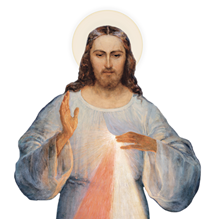
Pilgrims at the Divine Mercy Shrine in Płock, where St. Faustina saw Jesus.
Poland is the ideal land for learning the art of pilgrimage. Its history and culture is deeply religious; it is filled with memories of some of the Church’s best-known saints; and famous churches and beautiful shrines cover the landscape.

Congratulations to Stephen J. Binz on winning Second Place in the "Travel/Catholic Pilgrimage" category of the 2023 Catholic Media Association Book Awards for his Marian Press book, The Way of Mercy: Pilgrimage in Catholic Poland.
As Divine Mercy is manifested throughout the universal Church, the spotlight continues to shine on the nation of Poland. Today, the people of Poland are hosting millions of evacuees from their war-torn neighbor, Ukraine — caring for them in their own homes rather than depositing them in refugee camps. The people of Poland remember well their own suffering in the 20th century when they were assaulted from Nazi Germany from the west and oppressed by the communism of Russia from the east.
But out of terrible suffering comes remarkable sanctity. During those dark decades arose the witness of great saints like Faustina Kowalska, Maximillian Kolbe, and Pope John Paul II. The trials of the Polish people throughout the 20th century made Poland the martyr of the nations, or in St. John Paul’s words, the “Golgotha of the modern world.” Yet, these sufferings have been transformed by God into a gift of mercy for the world. And it seems to be the special mission of the Polish Church to be a witness of that gift and the bearer of the grace of Divine Mercy for our times.
Travel discoveries
I’ve been leading pilgrimages for over 30 years, but only in the past decade have I discovered the holy land of Poland. My first trip to Poland was led by a Jewish survivor of the Holocaust, the late Eva Mozes Kor. She taught me about the rich Jewish tradition of Warsaw and Kraków, the tragedy of the ghettos, and the Nazis’ “Final Solution.” After being tortured at Auschwitz by the Nazi doctor Josef Mengele, later in life she chose to free herself from bitterness by forgiving all her persecutors.
My next trip to Poland was during the Jubilee Year of Mercy, called by Pope Francis for 2016. During that year I wrote a Bible study entitled Divine Mercy, presented 30 parish missions on the theme of God’s mercy, and finally led a pilgrimage of eager Catholics to explore the sites in Poland associated with some of the merciful 20th-century saints: Faustina, Kolbe, and John Paul. Now I regularly lead groups on pilgrimage through Poland, each time being enriched by more places, history, and sanctity in this fascinating land.
And this year, as the culmination of my biblical study on mercy and my travels through Poland, I’ve written a book, The Way of Mercy: Pilgrimage in Catholic Poland (Marian Press, 2022). I know that for many reasons people are unable to travel on a physical tour of Poland, but everyone can take an armchair pilgrimage through the cities, churches, and shrines of Poland, and so explore the rich tradition of mercy and sanctity with which this land is blessed.
A nation of saints
Pilgrimage is a unique kind of travel: it requires eyes open to new sights and a heart open to being changed. Whether you are an adventurous traveler (preparing for a physical journey to Poland), or an imaginative traveler (visualizing the places of this land from an armchair), the experience of pilgrimage is transformative. The goal of pilgrimage is to allow the saints, shrines, and prayer to deepen your faith and form you more fully into disciples of Jesus.
Poland is the ideal land for learning the art of pilgrimage. Its history and culture is deeply religious; it is filled with memories of some of the Church’s best-known saints; and famous churches and beautiful shrines cover the landscape. The sacramental imagination distinctive to Catholicism allows us to experience God’s invisible, immaterial, and universal presence through the visible, material, and particular places.
Through the lives of the saints and events of sacred history, certain places have come to be viewed as holy sites where the veil between Heaven and earth is particularly translucent. Increasingly, more and more pilgrims from throughout the world are discovering Poland as the ideal place for a transforming encounter with God.
As I’ve explored Catholic Poland, I’ve come to realize that the climactic events of the last century were only possible because of the rich Christian tradition of over a thousand years in Poland. The patron saints of Poland, like St. Wojciech, St. Stanisław, and St. Jadwiga, are the sturdy pillars supporting the Church of Poland through the ages.
Cloud of witnesses
On the shoulders of these faithful giants, the Polish saints of our era stand. They are some of the earliest of that remarkable cloud of witnesses — the martyrs, bishops, confessors, and holy ones — that has sustained the faith of Poland throughout its history.
Likewise, I’ve discovered other saints, perhaps less well known than the most ancient and the most recent. I realize that there could never have been a Cardinal Wojtyła without a Cardinal Wyszynski, fortifying the church as it passed through the fire of totalitarian rule. The inspiring insights of St. Faustina in the 20th century flowed from the beautiful compassion for the poor exhibited by St. Albert Chmielowski in the 19th century. And Poland became a free country again at the end of the 20th century, not only because of the witness of Pope John Paul II, but also because of the martyrdom of Blessed Jerzy Popiełuszko.
All of these heroic saints are strands of the golden thread of Divine Mercy woven through the fabric of Poland’s history.
Stephen J. Binz is a Catholic biblical scholar, an award-winning author, and a popular pilgrimage leader. Learn more on www.Bridge-B.com.
{shopmercy-ad}

















